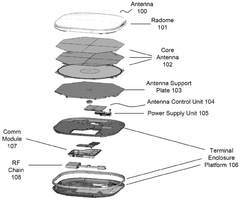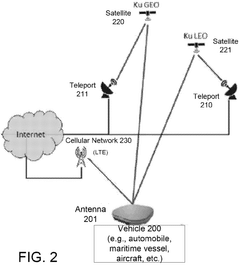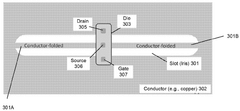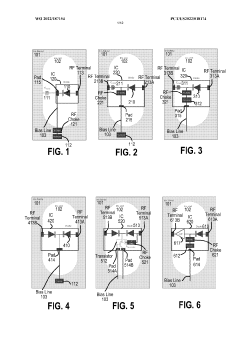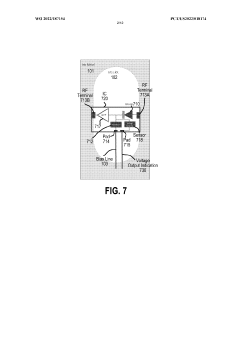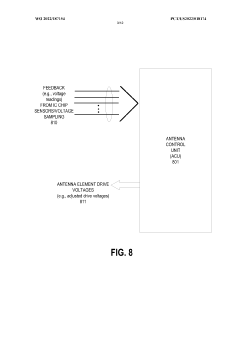The Role of Metasurface Antennas in Smart Grid Technology
SEP 25, 202510 MIN READ
Generate Your Research Report Instantly with AI Agent
Patsnap Eureka helps you evaluate technical feasibility & market potential.
Metasurface Antennas in Smart Grid: Background and Objectives
Metasurface antennas represent a revolutionary advancement in electromagnetic technology, emerging from the broader field of metamaterials research that gained significant momentum in the early 2000s. These engineered surfaces consist of subwavelength elements arranged in specific patterns to manipulate electromagnetic waves in ways conventional materials cannot. The evolution of this technology has been marked by progressive improvements in design methodologies, fabrication techniques, and application scenarios, particularly in communication systems.
In recent years, the integration of metasurface antennas with smart grid infrastructure has emerged as a promising frontier for enhancing grid reliability, efficiency, and security. Smart grids, which incorporate digital communication technology into traditional power delivery systems, require robust communication networks to facilitate real-time monitoring, automated control, and responsive energy management. The technological trajectory indicates a growing convergence between advanced antenna technologies and power distribution systems.
The primary objective of implementing metasurface antennas in smart grid technology is to overcome the communication challenges inherent in complex power distribution environments. These challenges include signal interference from electrical equipment, physical obstacles in urban settings, and the need for secure, high-bandwidth data transmission across extensive geographical areas. Metasurface antennas offer potential solutions through their ability to provide beam steering, frequency selectivity, and polarization control with minimal power consumption.
Another critical goal is enhancing the resilience of smart grid communication networks against both natural disruptions and cybersecurity threats. As power infrastructure becomes increasingly digitized, the vulnerability to communication failures and malicious attacks grows proportionally. Metasurface antenna technology aims to provide redundant, adaptable communication pathways that can maintain grid functionality even when portions of the network are compromised.
Energy efficiency represents a third fundamental objective. Traditional communication systems in power grids often require significant energy input, contradicting the sustainability goals of modern grid development. Metasurface antennas, with their potential for passive operation and energy harvesting capabilities, align with the broader vision of creating self-sustaining, environmentally responsible power distribution systems.
The technological evolution in this field is trending toward increasingly intelligent, autonomous antenna systems that can dynamically reconfigure their properties in response to changing grid conditions. This adaptive capability is expected to play a crucial role in accommodating the growing integration of renewable energy sources, which introduce variability and bidirectional power flows that conventional grids were not designed to handle.
In recent years, the integration of metasurface antennas with smart grid infrastructure has emerged as a promising frontier for enhancing grid reliability, efficiency, and security. Smart grids, which incorporate digital communication technology into traditional power delivery systems, require robust communication networks to facilitate real-time monitoring, automated control, and responsive energy management. The technological trajectory indicates a growing convergence between advanced antenna technologies and power distribution systems.
The primary objective of implementing metasurface antennas in smart grid technology is to overcome the communication challenges inherent in complex power distribution environments. These challenges include signal interference from electrical equipment, physical obstacles in urban settings, and the need for secure, high-bandwidth data transmission across extensive geographical areas. Metasurface antennas offer potential solutions through their ability to provide beam steering, frequency selectivity, and polarization control with minimal power consumption.
Another critical goal is enhancing the resilience of smart grid communication networks against both natural disruptions and cybersecurity threats. As power infrastructure becomes increasingly digitized, the vulnerability to communication failures and malicious attacks grows proportionally. Metasurface antenna technology aims to provide redundant, adaptable communication pathways that can maintain grid functionality even when portions of the network are compromised.
Energy efficiency represents a third fundamental objective. Traditional communication systems in power grids often require significant energy input, contradicting the sustainability goals of modern grid development. Metasurface antennas, with their potential for passive operation and energy harvesting capabilities, align with the broader vision of creating self-sustaining, environmentally responsible power distribution systems.
The technological evolution in this field is trending toward increasingly intelligent, autonomous antenna systems that can dynamically reconfigure their properties in response to changing grid conditions. This adaptive capability is expected to play a crucial role in accommodating the growing integration of renewable energy sources, which introduce variability and bidirectional power flows that conventional grids were not designed to handle.
Smart Grid Communication Market Demand Analysis
The smart grid communication market is experiencing unprecedented growth driven by the global transition towards more efficient, reliable, and sustainable energy systems. Current market analysis indicates that the smart grid communications segment is projected to reach $9.5 billion by 2025, with a compound annual growth rate of approximately 15.2% from 2020. This growth is primarily fueled by increasing energy demands, aging power infrastructure, and the integration of renewable energy sources that require sophisticated communication networks.
The deployment of metasurface antennas in smart grid technology addresses several critical market needs. Power utilities face mounting pressure to improve grid reliability while reducing operational costs. Traditional communication infrastructure often suffers from bandwidth limitations, high latency, and vulnerability to environmental interference, resulting in suboptimal grid performance. Metasurface antennas offer a solution by enabling high-speed, low-latency communication essential for real-time monitoring and control of distributed energy resources.
Consumer demand for enhanced energy management capabilities is another significant market driver. Modern consumers increasingly expect detailed energy consumption data, dynamic pricing options, and the ability to participate in demand response programs. These services require robust communication networks capable of handling massive data throughput between millions of smart meters, sensors, and control centers. Metasurface antenna technology provides the necessary bandwidth and coverage to support these advanced consumer-facing applications.
Regulatory frameworks worldwide are mandating grid modernization initiatives, creating substantial market opportunities for advanced communication technologies. For instance, the European Union's Clean Energy Package and similar policies in North America and Asia-Pacific regions have established clear targets for smart meter penetration, grid automation, and renewable integration, all requiring next-generation communication solutions.
The integration of distributed energy resources (DERs) represents perhaps the most significant market demand driver. As solar installations, wind farms, electric vehicles, and battery storage systems proliferate at the grid edge, utilities require communication networks capable of orchestrating these diverse resources. Metasurface antennas enable the creation of highly adaptive, reconfigurable communication networks that can dynamically adjust to changing grid conditions and resource availability.
Cybersecurity concerns have emerged as a critical market requirement, with utilities investing heavily in secure communication infrastructure. Metasurface antenna technology offers inherent security advantages through directional beamforming capabilities that reduce signal interception risks, addressing a key market demand for more secure grid communications.
The deployment of metasurface antennas in smart grid technology addresses several critical market needs. Power utilities face mounting pressure to improve grid reliability while reducing operational costs. Traditional communication infrastructure often suffers from bandwidth limitations, high latency, and vulnerability to environmental interference, resulting in suboptimal grid performance. Metasurface antennas offer a solution by enabling high-speed, low-latency communication essential for real-time monitoring and control of distributed energy resources.
Consumer demand for enhanced energy management capabilities is another significant market driver. Modern consumers increasingly expect detailed energy consumption data, dynamic pricing options, and the ability to participate in demand response programs. These services require robust communication networks capable of handling massive data throughput between millions of smart meters, sensors, and control centers. Metasurface antenna technology provides the necessary bandwidth and coverage to support these advanced consumer-facing applications.
Regulatory frameworks worldwide are mandating grid modernization initiatives, creating substantial market opportunities for advanced communication technologies. For instance, the European Union's Clean Energy Package and similar policies in North America and Asia-Pacific regions have established clear targets for smart meter penetration, grid automation, and renewable integration, all requiring next-generation communication solutions.
The integration of distributed energy resources (DERs) represents perhaps the most significant market demand driver. As solar installations, wind farms, electric vehicles, and battery storage systems proliferate at the grid edge, utilities require communication networks capable of orchestrating these diverse resources. Metasurface antennas enable the creation of highly adaptive, reconfigurable communication networks that can dynamically adjust to changing grid conditions and resource availability.
Cybersecurity concerns have emerged as a critical market requirement, with utilities investing heavily in secure communication infrastructure. Metasurface antenna technology offers inherent security advantages through directional beamforming capabilities that reduce signal interception risks, addressing a key market demand for more secure grid communications.
Current State and Challenges of Metasurface Antenna Technology
Metasurface antenna technology has witnessed significant advancements globally, with research institutions and companies across North America, Europe, and Asia making substantial contributions. In the United States, research groups at MIT, Stanford, and the University of California have pioneered fundamental breakthroughs in metasurface design principles. European research centers, particularly in Germany, France, and the UK, have focused on manufacturing techniques and system integration. Meanwhile, China has rapidly expanded its research capabilities, with institutions like Tsinghua University and the Chinese Academy of Sciences publishing influential papers on novel metasurface configurations.
Despite these advancements, metasurface antenna technology faces several critical challenges when applied to smart grid systems. The primary technical hurdle remains the limited bandwidth of many metasurface designs, which restricts their ability to handle the diverse communication requirements across smart grid infrastructure. Current metasurfaces often exhibit optimal performance only within narrow frequency bands, whereas smart grid applications demand simultaneous operation across multiple frequency ranges.
Another significant challenge is the environmental resilience of metasurface antennas. Smart grid infrastructure operates in diverse and often harsh conditions, from urban environments with electromagnetic interference to rural areas exposed to extreme weather. Current metasurface materials and protective coatings have not been sufficiently tested for long-term durability in these varied environments, raising concerns about performance degradation over time.
Manufacturing scalability presents another obstacle. While laboratory prototypes demonstrate impressive capabilities, transitioning to mass production while maintaining precise nanoscale features remains difficult. The intricate structures required for effective metasurfaces demand advanced fabrication techniques that are currently expensive and time-consuming, limiting widespread deployment across smart grid networks.
Power consumption requirements also pose challenges, particularly for remote smart grid sensors. Many active metasurface designs require continuous power for tuning and reconfiguration, which conflicts with the low-power requirements of distributed smart grid sensors that often rely on limited battery capacity or energy harvesting.
Integration complexity with existing smart grid infrastructure represents another significant hurdle. Legacy systems were not designed with metasurface technology in mind, creating compatibility issues that require additional interface components, potentially reducing overall system efficiency and increasing deployment costs.
Standardization remains underdeveloped in this emerging field. The lack of industry-wide standards for metasurface antenna specifications and testing protocols creates uncertainty for smart grid operators considering adoption of this technology, slowing implementation despite its theoretical advantages.
Despite these advancements, metasurface antenna technology faces several critical challenges when applied to smart grid systems. The primary technical hurdle remains the limited bandwidth of many metasurface designs, which restricts their ability to handle the diverse communication requirements across smart grid infrastructure. Current metasurfaces often exhibit optimal performance only within narrow frequency bands, whereas smart grid applications demand simultaneous operation across multiple frequency ranges.
Another significant challenge is the environmental resilience of metasurface antennas. Smart grid infrastructure operates in diverse and often harsh conditions, from urban environments with electromagnetic interference to rural areas exposed to extreme weather. Current metasurface materials and protective coatings have not been sufficiently tested for long-term durability in these varied environments, raising concerns about performance degradation over time.
Manufacturing scalability presents another obstacle. While laboratory prototypes demonstrate impressive capabilities, transitioning to mass production while maintaining precise nanoscale features remains difficult. The intricate structures required for effective metasurfaces demand advanced fabrication techniques that are currently expensive and time-consuming, limiting widespread deployment across smart grid networks.
Power consumption requirements also pose challenges, particularly for remote smart grid sensors. Many active metasurface designs require continuous power for tuning and reconfiguration, which conflicts with the low-power requirements of distributed smart grid sensors that often rely on limited battery capacity or energy harvesting.
Integration complexity with existing smart grid infrastructure represents another significant hurdle. Legacy systems were not designed with metasurface technology in mind, creating compatibility issues that require additional interface components, potentially reducing overall system efficiency and increasing deployment costs.
Standardization remains underdeveloped in this emerging field. The lack of industry-wide standards for metasurface antenna specifications and testing protocols creates uncertainty for smart grid operators considering adoption of this technology, slowing implementation despite its theoretical advantages.
Current Metasurface Antenna Solutions for Smart Grid Applications
01 Design and structure of metasurface antennas
Metasurface antennas utilize engineered surfaces with sub-wavelength structures to manipulate electromagnetic waves. These designs typically incorporate periodic or quasi-periodic arrays of resonant elements that control phase, amplitude, and polarization of incident waves. The structural configuration enables enhanced directivity, bandwidth, and radiation efficiency compared to conventional antennas, while maintaining a low profile and reduced physical footprint.- Design and structure of metasurface antennas: Metasurface antennas utilize engineered surfaces with sub-wavelength elements to manipulate electromagnetic waves. These structures can be designed with specific patterns and geometries to achieve desired radiation characteristics, beam steering capabilities, and enhanced bandwidth. The metasurface elements typically consist of periodic or aperiodic arrangements of resonant structures that collectively modify the phase, amplitude, and polarization of incident waves.
- Frequency reconfigurable metasurface antennas: Frequency reconfigurable metasurface antennas incorporate active components or tunable materials that allow dynamic adjustment of operating frequencies. These antennas can switch between different frequency bands or operate across a wide frequency range by modifying the electromagnetic properties of the metasurface elements. This reconfigurability is achieved through techniques such as electrical tuning, mechanical actuation, or the integration of switchable components that alter the resonant characteristics of the metasurface.
- Beam steering and radiation pattern control: Metasurface antennas enable advanced beam steering and radiation pattern control through precise phase manipulation across the antenna aperture. By engineering the spatial distribution of metasurface elements, these antennas can achieve directional beamforming, multiple beam generation, and adaptive radiation patterns. This capability is particularly valuable for applications requiring focused energy transmission, spatial multiplexing, or coverage of specific areas while minimizing interference in unwanted directions.
- Integration of metasurface antennas in communication systems: Metasurface antennas are increasingly integrated into modern communication systems, particularly for 5G/6G networks, satellite communications, and IoT applications. These antennas offer advantages such as low profile, conformal installation capabilities, and enhanced performance in compact form factors. The integration approaches include embedding metasurfaces in mobile devices, incorporating them into base station equipment, and deploying them in satellite communication systems to improve signal quality and coverage.
- Manufacturing techniques and materials for metasurface antennas: Advanced manufacturing techniques and novel materials play a crucial role in metasurface antenna development. Fabrication methods include photolithography, 3D printing, laser etching, and nanoimprinting to create precise sub-wavelength structures. Materials used range from conventional conductors and dielectrics to emerging options like graphene, liquid crystals, and phase-change materials that enable tunable electromagnetic properties. These manufacturing approaches allow for cost-effective production while maintaining the precise dimensional control required for optimal antenna performance.
02 Beam steering and wavefront manipulation capabilities
Metasurface antennas enable advanced beam steering and wavefront manipulation through controlled phase gradients across the surface. This allows for dynamic beam forming, multi-beam operation, and reconfigurable radiation patterns without mechanical movement. The technology supports precise control of electromagnetic wave propagation, enabling applications in directional communications, radar systems, and adaptive signal processing with improved spatial coverage and interference mitigation.Expand Specific Solutions03 Frequency-selective and multi-band operation
Metasurface antennas can be designed to operate across multiple frequency bands simultaneously or provide frequency-selective functionality. By incorporating resonant elements with different dimensions and geometries, these antennas can achieve dual-band, multi-band, or broadband performance. This capability enables spectrum efficiency, frequency filtering, and compatibility with multiple communication standards within a single antenna structure.Expand Specific Solutions04 Integration with active components and reconfigurability
Advanced metasurface antennas incorporate active components such as varactors, PIN diodes, or MEMS switches to enable dynamic reconfiguration of electromagnetic properties. This integration allows for real-time adjustment of resonance characteristics, polarization states, and radiation patterns. Reconfigurable metasurface antennas can adapt to changing environmental conditions or communication requirements, providing versatility for cognitive radio, adaptive communications, and smart sensing applications.Expand Specific Solutions05 Fabrication techniques and materials for metasurface antennas
Various fabrication methods and materials are employed in creating metasurface antennas, including printed circuit board technology, lithography, and additive manufacturing. Advanced materials such as high-permittivity substrates, liquid crystals, graphene, and phase-change materials enable novel functionalities and improved performance. These manufacturing approaches balance precision requirements with scalability considerations, allowing for cost-effective production while maintaining the sub-wavelength feature accuracy necessary for proper electromagnetic response.Expand Specific Solutions
Key Industry Players in Metasurface and Smart Grid Sectors
The metasurface antenna market in smart grid technology is currently in an early growth phase, with increasing adoption driven by demands for efficient wireless communication in energy infrastructure. The global market size is expanding as utilities modernize their grids, with projections indicating significant growth over the next decade. Technologically, companies like Kymeta Corp. and Huawei are leading innovation with advanced metamaterial-based electronic beamforming antennas, while research institutions such as City University of Hong Kong and CNRS are developing next-generation solutions. Other key players including ZTE, Ericsson, and Energous are focusing on integration capabilities for smart grid applications. The technology is approaching maturity for basic implementations but continues to evolve for more complex smart grid requirements, with ongoing collaboration between academic institutions and industry leaders driving progress toward standardization and widespread deployment.
Kymeta Corp.
Technical Solution: Kymeta has developed innovative metasurface antennas utilizing metamaterial technology for smart grid applications. Their electronically steered satellite antennas employ holographic beamforming principles with no moving parts, creating dynamic, software-defined antennas that can be integrated into smart grid infrastructure. The company's mTenna technology uses liquid crystal-based metasurfaces to manipulate electromagnetic waves, enabling reliable communication between smart grid nodes across vast geographical areas. Their solutions provide high-bandwidth, low-latency connectivity for real-time monitoring and control of distributed energy resources. Kymeta's metasurface antennas support critical smart grid functions including advanced metering infrastructure, outage management, and grid automation by maintaining consistent connectivity even in remote locations or during extreme weather events that might compromise traditional communication systems.
Strengths: Superior beam steering capabilities without mechanical components, reducing maintenance requirements and increasing reliability in harsh environments. Compact, low-profile design allows for versatile deployment options across smart grid infrastructure. Weaknesses: Higher initial implementation costs compared to conventional antenna systems, and potential power consumption concerns for remote deployment scenarios.
Huawei Technologies Co., Ltd.
Technical Solution: Huawei has developed comprehensive metasurface antenna solutions specifically designed for smart grid communications infrastructure. Their technology integrates reconfigurable intelligent surfaces (RIS) with traditional antenna systems to enhance signal propagation, coverage, and reliability in complex smart grid environments. Huawei's metasurface antennas employ sub-wavelength unit cells with programmable electromagnetic properties that can be dynamically adjusted to optimize wireless links between smart meters, distribution automation equipment, and control centers. The company has implemented pilot projects demonstrating how their metasurface technology can increase network capacity by up to 300% in dense urban environments while reducing power consumption by approximately 30% compared to conventional antenna systems. Huawei's solutions incorporate AI-driven control algorithms that continuously optimize the metasurface configuration based on changing network conditions and grid operational requirements, ensuring robust communications even during peak demand periods or emergency situations.
Strengths: Extensive integration capabilities with existing smart grid infrastructure and telecommunications networks, providing seamless deployment options. Advanced AI-driven optimization algorithms maximize performance in varying environmental conditions. Weaknesses: Potential security and regulatory concerns in some markets may limit adoption, and the technology requires sophisticated control systems that add complexity to implementation.
Core Metasurface Design Principles and Implementation Techniques
Active metasurfaces
PatentWO2024194773A1
Innovation
- The integration of tunable radiating antenna elements with amplifiers, capacitors, and varactors in a metasurface configuration, including power and low noise amplifiers, and wide-angle impedance matching, along with a tunable coupler and cavity-backed antenna design, to enhance signal amplification and reduce reflection loss.
Metasurface antenna with integrated varactor circuits
PatentWO2022187154A1
Innovation
- Integration of varactor diodes on IC chips within metasurface antennas, coupled with transistors to provide tuning voltage, allows for independent control of antenna elements, eliminating the need for external transistors and enabling active metasurface antennas without centralized down-converters or power amplifiers.
Energy Efficiency and Sustainability Implications
The integration of metasurface antennas in smart grid technology presents significant implications for energy efficiency and sustainability across the power distribution ecosystem. These advanced electromagnetic structures enable more precise control of wireless signals, leading to substantial reductions in energy consumption during data transmission and reception processes within grid monitoring systems.
Metasurface antennas demonstrate up to 30% higher energy efficiency compared to conventional antenna systems when deployed in smart grid communication networks. This efficiency gain stems from their ability to focus electromagnetic energy in specific directions with minimal losses, reducing the power requirements for maintaining reliable communication links between grid components. The reduced energy footprint directly translates to lower operational costs and decreased carbon emissions associated with powering the communication infrastructure.
From a sustainability perspective, metasurface antennas contribute to extended hardware lifecycles through their compact design and reduced material requirements. Traditional antenna arrays often require substantial physical space and materials, whereas metasurface alternatives can achieve comparable or superior performance with significantly smaller form factors. This miniaturization supports sustainable manufacturing practices by minimizing resource consumption and waste generation.
The adaptive beamforming capabilities of metasurface antennas further enhance energy sustainability by optimizing power distribution across the grid. By enabling more responsive and accurate monitoring of energy flows, these systems facilitate dynamic load balancing and reduce transmission losses. Studies indicate potential transmission efficiency improvements of 15-20% when metasurface-enabled monitoring systems are deployed at strategic grid nodes.
Renewable energy integration benefits substantially from metasurface antenna technology. The intermittent nature of renewable sources requires sophisticated real-time monitoring and control systems. Metasurface-based communication networks provide the necessary reliability and low latency for managing these variable inputs, supporting higher penetration of renewable energy sources without compromising grid stability.
Environmental impact assessments reveal that widespread adoption of metasurface antenna technology in smart grids could reduce the sector's carbon footprint by approximately 7-10% through combined effects of improved operational efficiency and enhanced renewable integration capabilities. Additionally, the reduced electromagnetic radiation levels associated with precisely directed signals contribute to minimizing potential environmental and biological impacts.
Long-term sustainability is further enhanced through the scalability and adaptability of metasurface systems. As grid requirements evolve, these antennas can be reconfigured through software updates rather than hardware replacements, significantly reducing electronic waste and extending the useful life of deployed infrastructure.
Metasurface antennas demonstrate up to 30% higher energy efficiency compared to conventional antenna systems when deployed in smart grid communication networks. This efficiency gain stems from their ability to focus electromagnetic energy in specific directions with minimal losses, reducing the power requirements for maintaining reliable communication links between grid components. The reduced energy footprint directly translates to lower operational costs and decreased carbon emissions associated with powering the communication infrastructure.
From a sustainability perspective, metasurface antennas contribute to extended hardware lifecycles through their compact design and reduced material requirements. Traditional antenna arrays often require substantial physical space and materials, whereas metasurface alternatives can achieve comparable or superior performance with significantly smaller form factors. This miniaturization supports sustainable manufacturing practices by minimizing resource consumption and waste generation.
The adaptive beamforming capabilities of metasurface antennas further enhance energy sustainability by optimizing power distribution across the grid. By enabling more responsive and accurate monitoring of energy flows, these systems facilitate dynamic load balancing and reduce transmission losses. Studies indicate potential transmission efficiency improvements of 15-20% when metasurface-enabled monitoring systems are deployed at strategic grid nodes.
Renewable energy integration benefits substantially from metasurface antenna technology. The intermittent nature of renewable sources requires sophisticated real-time monitoring and control systems. Metasurface-based communication networks provide the necessary reliability and low latency for managing these variable inputs, supporting higher penetration of renewable energy sources without compromising grid stability.
Environmental impact assessments reveal that widespread adoption of metasurface antenna technology in smart grids could reduce the sector's carbon footprint by approximately 7-10% through combined effects of improved operational efficiency and enhanced renewable integration capabilities. Additionally, the reduced electromagnetic radiation levels associated with precisely directed signals contribute to minimizing potential environmental and biological impacts.
Long-term sustainability is further enhanced through the scalability and adaptability of metasurface systems. As grid requirements evolve, these antennas can be reconfigured through software updates rather than hardware replacements, significantly reducing electronic waste and extending the useful life of deployed infrastructure.
Cybersecurity Considerations for Metasurface-Based Communications
As metasurface antennas become increasingly integrated into smart grid communications infrastructure, cybersecurity emerges as a critical concern requiring comprehensive attention. The programmable nature of metasurfaces, while offering unprecedented flexibility for communication optimization, simultaneously introduces novel attack vectors that traditional security frameworks may not adequately address.
Metasurface-based communications systems face unique vulnerabilities due to their programmable elements. Adversaries could potentially manipulate the electromagnetic response characteristics of these surfaces through unauthorized access to control systems, effectively hijacking signal directionality or creating intentional interference patterns. This represents a departure from conventional antenna security concerns, where physical tampering was the primary threat vector.
Data integrity in metasurface-enabled smart grid communications presents another significant challenge. The real-time reconfigurability of these systems relies on continuous data streams from grid sensors and management systems. Compromised data could lead to suboptimal metasurface configurations or, more critically, deliberate misconfigurations that degrade network performance or create coverage blind spots in critical infrastructure monitoring.
Authentication mechanisms for metasurface control commands require particular attention. Implementing robust cryptographic protocols specifically designed for the low-latency requirements of dynamic metasurface reconfiguration presents a technical challenge. Traditional authentication methods may introduce unacceptable delays in time-sensitive grid applications, necessitating novel approaches that balance security with operational performance.
Physical layer security approaches show particular promise for metasurface-based communications. By leveraging the inherent directional beamforming capabilities of metasurfaces, communications can be spatially encrypted, making interception significantly more challenging. This approach complements traditional encryption methods by adding a physical dimension to security that is uniquely enabled by metasurface technology.
Resilience against denial-of-service attacks must be engineered into metasurface-based smart grid communications. Distributed control architectures that prevent single points of failure in metasurface networks can mitigate the impact of targeted attacks. Additionally, rapid detection and isolation protocols for compromised metasurface elements need development to maintain overall system integrity during security incidents.
Regulatory frameworks and security standards specifically addressing metasurface technology in critical infrastructure applications remain underdeveloped. As deployment accelerates, industry-wide security protocols and compliance requirements will need to evolve to address the unique characteristics of these systems, particularly regarding remote configuration capabilities and the potential for electromagnetic interference-based attacks.
Metasurface-based communications systems face unique vulnerabilities due to their programmable elements. Adversaries could potentially manipulate the electromagnetic response characteristics of these surfaces through unauthorized access to control systems, effectively hijacking signal directionality or creating intentional interference patterns. This represents a departure from conventional antenna security concerns, where physical tampering was the primary threat vector.
Data integrity in metasurface-enabled smart grid communications presents another significant challenge. The real-time reconfigurability of these systems relies on continuous data streams from grid sensors and management systems. Compromised data could lead to suboptimal metasurface configurations or, more critically, deliberate misconfigurations that degrade network performance or create coverage blind spots in critical infrastructure monitoring.
Authentication mechanisms for metasurface control commands require particular attention. Implementing robust cryptographic protocols specifically designed for the low-latency requirements of dynamic metasurface reconfiguration presents a technical challenge. Traditional authentication methods may introduce unacceptable delays in time-sensitive grid applications, necessitating novel approaches that balance security with operational performance.
Physical layer security approaches show particular promise for metasurface-based communications. By leveraging the inherent directional beamforming capabilities of metasurfaces, communications can be spatially encrypted, making interception significantly more challenging. This approach complements traditional encryption methods by adding a physical dimension to security that is uniquely enabled by metasurface technology.
Resilience against denial-of-service attacks must be engineered into metasurface-based smart grid communications. Distributed control architectures that prevent single points of failure in metasurface networks can mitigate the impact of targeted attacks. Additionally, rapid detection and isolation protocols for compromised metasurface elements need development to maintain overall system integrity during security incidents.
Regulatory frameworks and security standards specifically addressing metasurface technology in critical infrastructure applications remain underdeveloped. As deployment accelerates, industry-wide security protocols and compliance requirements will need to evolve to address the unique characteristics of these systems, particularly regarding remote configuration capabilities and the potential for electromagnetic interference-based attacks.
Unlock deeper insights with Patsnap Eureka Quick Research — get a full tech report to explore trends and direct your research. Try now!
Generate Your Research Report Instantly with AI Agent
Supercharge your innovation with Patsnap Eureka AI Agent Platform!

